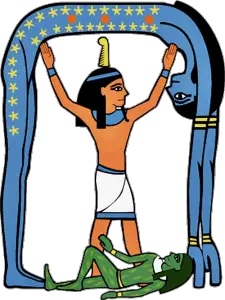Who the God Shu is
In the religious belief system, the personification of natural forces had been a common phenomenon all over the world. Shu was considered as the personification of air in ancient Egypt. Apart from this, he was also known to be the god of the atmosphere as well as sunlight.

What does the Name Shu Mean
The meaning of Shu is ’emptiness’ as well as ‘he who rises up’. This types of meanings of his name clearly indicate his association with air as well as the sun. The symbol of a ‘feather’ was used as the hieroglyphic symbol to represent Shu.
Heliopolitan View
There were various religious views in ancient Egypt holding the mythologies of creation and the birth of deities. These views were basically the results of the then present political condition. The Heliopolitan view emerged as a strong religious view constructed by the priests of Heliopolis to the emphasis on the Solar origin of everything.
Ennead of Heliopolis
Heliopolitan view basically talks about the supremacy of sun god Atum, how he created the universe and how the other deities came into being by him. ‘Ennead of Heliopolis’ is a group of nine major gods and goddesses consisting Atum, Shu, Tefnut, Geb, Nut, Osiris, Isis, Seth and Nephthys. According to Heliopolitan mythology, Shu was believed to be created either from semen or from the mucus of sun god Atum.
Shu Family Tree
Atum created two deities; Shu, god of air and Tefnut, Goddess of moisture. Shu was also considered as the husband of Tefnut. They produced another two deities that were Earth God Geb and Sky Goddess Nut. Geb and Nut produced another four deities that were Osiris, Isis, Seth and Nephthys.

Twin Lion Deities Shu and Tefnut
Shu along with his wife-sister Tefnut had a significant role in Heliopolitan philosophy. The importance of these two deities can be seen in their famous ‘Two Lions’ form. In this form, both the deities are represented in form of a lion.

Separation of Nut and Geb
According to Heliopolitan mythology, Geb and Nut, children deities of Shu and Tefnut were being separated from each other. This work was initiated by their father Shu. He did this because Geb became angry with Nut when Nut swallowed their children; the constellations.
This mythical story of separation was also reflected in the art. Here Shu, Nut and Geb have depicted altogether where Shu is supporting Nut by his raised hands and holding her apart from his wife Geb with the help of magical deities who were known as ‘Heh’ deities.

Iconography of Shu
Several types of depictions of Shu can be seen in ancient Egyptian art. The most popular depictions were his human form where he wears a feather as his symbol. Sometimes he is also depicted in lion form as well as in a trio form along with Nut and Geb. Sometimes he is also represented supporting a sun disk.
While discussing several depictions of Shu in Egyptian art, one example must be mentioned here. The image of Shu, recovered from the tomb of King Tutankhamen, is an ivory head-rest where Shu is supporting the head of the king, symbolically represented here as sun along with the symbolism of the ‘Twin Lions’.

Shu an Ancient King
There was another mythology where Shu was shown as a king of ancient Egypt who ruled for a long time. When he felt weak and became tired, he went to heaven. This story is well depicted in a Ptolemaic period granite shrine.
Lunar Association of Shu
Lunar deities Knonsu and Thoth were many times shown in association with the god Shu. The reason behind this association may have been formed because of the association of Tefnut with the moon.
Cult Centre
Ancient Egyptian deities had their specific own cult centres where they were given huge respect. Shu came in predominance with his own specific cult centre during the period of New Kingdom. His cult centre was ancient Nay-ta-hut which can be identified with the present-day Tell-el-Muqdam.
In Greeks’ version, Shu’s cult centre was known as Lentopolis which indicates that this was a lion city where lion-faced deities were worshipped. In his cult centre, Shu was widely worshipped along with his wife Tefnut.
